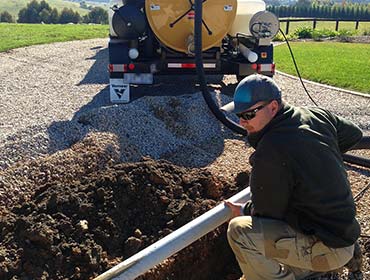The demand for non-destructive digging (NDD) solutions has seen a surge in demand for vacuum excavation across a wide range of industries and applications. We spoke to Vermeer Australia National Marketing Manager Steve Reeves about the many opportunities that this technology offers to Australia’s Arboriculture Contractors.
This surge in demand for vacuum excavation across the Australian construction industry is being driven by factors including the increased mandating of NDD by municipalities and asset owners, the availability of vacuum excavators in a wide range of sizes and configurations, their cost-effectiveness, and the diverse applications of this technology to today’s job sites.
“Often, once a contractor buys their first vacuum excavator, its use expands beyond the intended application, realising new revenue streams and/or efficiencies in their business. Today’s trailer-mounted vacuum excavators, like Vermeer’s VX30-250, are well-suited to tree care and open space maintenance applications due to their portability and as only one person is required to operate the unit.”
How does vacuum excavation work?
A vacuum excavator uses high-pressure water from a handheld wand to break down soil, which is then removed by high-volume air through a vacuum hose and deposited into a spoil tank on the unit.
“This process is inherently non-destructive, hence the term non-destructive digging or NDD. The high-pressure water and vacuum can also be used independently for many tasks, including water blasting to clean objects and vacuuming of solid and liquid waste.” Said Mr Reeves.
Vacs are typically available in compact trailer-mounted models, with larger truck-mounted vacs chosen for higher volume applications.
Applications in Arboriculture
Its inherently non-destructive nature means that vacuum excavation is an ideal means of excavating around sensitive trees and infrastructure. The use of appropriate nozzles and water pressure enables excavation without damage to trees for tasks such as root inspection as part of pest insect and disease management, root deflector/ barrier installations, selective root pruning and isolation of root ball in transplanting. As a means of excavating for tree planting, there is the added benefit of water being introduced as part of the process.
Damaging existing utilities can be very costly in terms of job downtime, significant fines from utility owners, and safety risk.
“When used correctly, the relatively non-destructive water and air pressure used in vacuum excavation will not damage existing utilities like a backhoe, excavator, or mattock. In practice, the process exposes and cleans off the roots and existing utilities, giving the operator access to work around or tap into them.”
When working in irrigation solenoid boxes filled with dirt or installing a new valve box, a vac can be used to gently remove dirt from around the sensitive solenoid wiring so you can get a clear view of the job.
As a tool for facilities maintenance, vacs have many uses including high-pressure water blasting, gutter cleaning and leaf fall removal, debris and liquid waste cleanup. If your tree care business undertakes any of this work as a supplement to arboriculture, a vac can provide a tangible new revenue stream and give you a more comprehensive offering, especially in our current climate of drought.
What vacuum excavator configuration is best for your business?
Trailer-mounted units offer great flexibility in applications where lower volumes of spoil are expected and offer the flexibility to use existing vehicle fleet. If your crews are regularly taking on larger jobs, a truck-mounted vacuum excavator may be the way to go.
Stump grinding? Electronic utility locators can reduce your risk.
We’ve all heard the stories of stump grinders damaging unmarked utilities and the asset owners that charge like a wounded bull for repairs. If the risk of costly strikes on underground assets like power, gas and water has you on-edge when working in urban areas, consider an electronic utility/cable locator like the Vermeer Verifier G3 locator by McLaughlin. It can help you quickly identify the location of underground assets, and is a cost-effective risk mitigation strategy.
Get to know the vac ex lingo
The power pack engine that powers the unit. Integrated silencing systems offer quieter operation and will keep you in favour with the site management on noise-sensitive job sites.
The air flow and suction rating of the blower determines the volume and weight of spoil that can be lifted, and from what depth. Blower output is typically described in cubic feet per minute (CFM), and is a key metric when you are assessing the performance of a vacuum excavator.
The other key metric that determines how much spoil can be lifted by a vacuum excavator is the vacuum capability of the blower, typically described in inches of mercury (inHg). If you’re lifting dense spoil or lifting spoil vertically over greater distances you will typically need a high vacuum rating.
Proximity to authorised dumping stations and carrying capacity of the intended vehicle are the two key considerations when determining spoil tank size.
Contact your local Vermeer dealership, or product specialist to learn more about vacuum excavation and Vermeer’s range of solutions for Australia’s Landscape Contractors.[/vc_column_text][vc_empty_space][/vc_column][/vc_row][vc_row css_animation=”” row_type=”row” use_row_as_full_screen_section=”no” type=”full_width” angled_section=”no” text_align=”left” background_image_as_pattern=”without_pattern”][vc_column][vc_column_text]
Take your pick
Trailer-mounted vacuum excavators
Trailer-mounted vacuum excavators offer great flexibility in applications where lower volumes of spoil are expected and offer the flexibility to use existing vehicle fleet. These units have all of the durability of larger units, and with portability and flexibility that enables them to take on a diverse range of tasks.

 MyDealer:
MyDealer:


